I’ve been fascinated by crowdfunding, and Kickstarter in particular, for a while now. I’ve been attending panels at various conventions, studying successful and not-so-successful campaigns, and reading articles or blog posts about the subject for four or five years. Also, as you may have gathered from all the posts about it on my blog, for the past two years I’ve been working on my own game that I’m planning on funding through Kickstarter, called No Honor Among Thieves. And finally I’ve recently begun being a bit more proactive and started asking questions and getting feedback from some of the crowdfunding veterans I’ve been following. I’ve made a bit of a study of it, is what I’m saying. Getting something published has been the dream for quite a while now, and I don’t want to spend all that time, work and passion on a project only to trip up at the goalpost.
When you read, listen to, watch or talk with enough of the people offering crowdfunding advice, you start to notice certain patterns. Everyone words it differently, and sometimes people offer contradictory advice, but there’s definitely a set of lessons that everyone seems to learn while going through this. I’ve seen a lot of that over the past few years of research, and I’ve tried to distill these lessons down into six main points, plus one that I learned myself and want to write down to remind myself about later.
This is going to be focused on games publishing through Kickstarter, because that’s what I’m interested in. The advice may also apply to other types of project and other crowdfunding platforms, but it’s the details will be about tabletop games.
1. Have a crowd before you begin
This is the big one, the advice that you’ll see over and over again if you do any amount of research into running a crowdfunding campaign. You can’t just go to Kickstarter without any preparation, hat in hand, and expect to be showered with cash to fund your wildest dreams. That doesn’t work. When you’re crowdfunding, you need to actually have a crowd to fund you, and they need to be a crowd that’s actually interested in what you’re doing.
This is the hardest one for a one-man first-time publisher trying to crowdfund a game, and one that I struggled with a lot until I realized I was already doing most of the things that I needed to do for it. I’ve had this blog since 2011, I regularly attend conventions with the game I’ve been working on, and I already comment on game forums to offer and ask advice. That’s the important thing, right there. You can’t build a crowd by offering no content. When you don’t have a game that people can buy quite yet, that means talking about things that people who might also be interested in your game are already interested in. Make stuff that you love, and make it good. That’s all it ever really takes.
On top of that, it helps to run a good social media presence. It’s better if you actually talk to people in the various mediums you use (Facebook, Twitter, Instagram, whatever), but even just having an automated script that notifies your Twitter followers when you make a blog post helps. I use a service called If This, Then That to post to my Carpe Omnis Games Facebook and Twitter whenever I write a post on the blog related to the game. I also post other news that I don’t think merits a full blog post directly to both FB and Twitter. I’m not super good at interacting with people on these platforms, especially Twitter, but even I admit that they’re valuable tools for letting people know you’re out there. They’re certainly excellent for having a conversation, since that’s what they were designed for.
Post stuff that you’re interested in, and have conversations that are helpful to yourself and to others. Offer advice and ask for advice. You can’t just walk out and buy a community, you have to put the work in to build one.
2. Be as finished as possible (but not completely finished)
You’re going to Kickstarter to pay for all the stuff you need to make your game, right?
No.
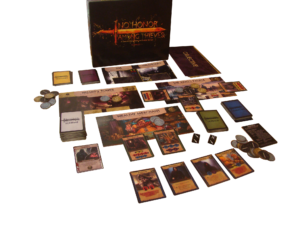
Your game should be made at this point. As much of it as possible. You should have the rules finalized already. The graphic design as done as you can get it. You should have art for as many cards or other components as you can afford (and if you can’t afford any, find some other way to make it look good–see point 3, below). People are going to want to read the rules, so you need them to be as close to done as you can get them, blind playtested front to back and mechanically rock solid. Your backers should be able to look at your game and get a good sense of what it is they’ll be buying, and whether or not it’s going to be worth pledging. You need to prove to people that you aren’t going to burn through their money without providing anything in return, and the best way to do that is to already have the final product most of the way done. Not 100% done–you’re on Kickstarter looking for funding after all, and if you look like you don’t need money then people aren’t going to trust that either–but to the point where you wouldn’t feel bad about putting the game on a table at a convention. Don’t make something that you’re ashamed to have your name attached to when you look back on it years later.
This leads directly into the next point…
3. Look good
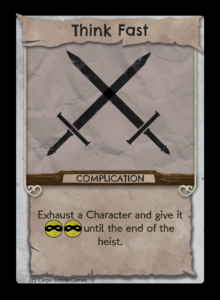
You need to look professional. This ties back into proving to people that you aren’t going to waste their money. If you haven’t put the work in when setting up your Kickstarter page, or when making your videos and your imagery and your graphic design, people have no reason to believe that you’d put the work in when designing the game they’re supposedly funding. This means you need to have a good video, a good banner image for the page, and pictures of your best-looking prototype. It means charts showing the breakdown of where the money is going to go, and how to play videos. It means no typos, good copy on the page, and high quality images breaking up the text. If you can’t make good graphics or good copy yourself, you’ll either need to hire someone to do it for you or buckle down and practice until you get it right.
This point might seem superficial, but look at it from a backer’s perspective. They’re busy, they’ve got work of their own to do, and they’re taking time out of their day to read through your Kickstarter page. You only get one first impression. Even if your rules are genius, if the first impression of your game is a phone camera picture of cards that you cut out of letter paper, no one is going to take the time to look further, because 99 times out of 100 when you see something like that the end result isn’t genius. Having a good looking page lets people know that you’re taking the project seriously.
4. Get reviewed
This one is pretty simple. Find tabletop game reviewers, contact them and offer to send a prototype copy of your game for them to review. Most of the time people will agree to post the reviews during your Kickstarter. The idea here is to give people some objective, third-party verification that your game is good. This list collected and maintained by James Mathe is a good place to start, as is this list by Jamey Stegmaier. This goes hand in hand with the work you should be doing to get a crowd before you launch.
Be warned–some reviewers, especially the bigger ones who get a lot of requests to review games, charge money for Kickstarter previews. This makes sense from their perspective, since a crowdfunded game is a bit riskier for them than an already published game. There’s the chance that the game might not come out at all, the chance that the rules they play and review won’t be the same ones that eventually get published, and the chance that the game is just godawful and in no fit state to be published or played. In my experience, prices range anywhere from $75 to $200. There are plenty who do it for free, so if you’re not willing to shell out some cash for this you can still get reviews, but don’t be surprised if you come across the ones who charge.
5. Know the numbers
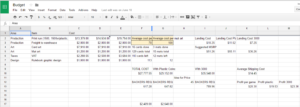
This one is pretty obvious to me, but from what I’ve been reading some people have had trouble with it in the past, so it’s a good thing to double check before you try to crowdfund your game. The rule is simple: know how much money you need, and for what. Before you launch, you should have quotes and estimates for every last thing you can think of. Manufacturing at multiple levels and with multiple sets of stretch goals, freight from the factory to the warehouse, distribution to backers, art and graphic design, the lot. You should know as best as you possibly can how much it will actually take to get this game made, and ask for a little more than that much money. Add a couple thousand dollars on top of it. Do not assume you will overfund, and set the funding goal lower than you actually need so that people get excited when they see how much it’s overfunded by. That’s a disaster begging to happen, and I keep being surprised that it would need to be mentioned, but apparently it’s an issue for some people.
You do want to ask for the least amount of money possible, but it should be the least amount of money possible while still getting the project done. Cut costs by working to get the best manufacturing and shipping quotes. It’s hard work, and you have to be careful to make sure that your super cheap option isn’t cheap due to terrible quality, but it can be done. Learn how to use some spreadsheet software (I use Google Sheets, personally) and get to work comparing numbers.
6. You will forget something, and it’s okay to delay things
Jamey Stegmaier says it best–you don’t have to launch today. What this boils down to is that if you don’t think you’re ready, for any reason at all, don’t launch. You’ve got to be a little careful with this one, because it can be easy to fall into a cycle of perfecting and delaying and never actually being finished, but most of the time when you have any concerns you can delay for a month and address them. I’ve done this a couple of times with No Honor Among Thieves, before coming to the point where I think I’m 100% ready. There’s still a lot to get done–I need to finish the Kickstarter video, for one thing–but it’s stuff that I can get done in a few weeks. The current plan is to launch the Kickstarter on August 30, and I’ll keep you posted if that changes at all.
Bonus: Do your due diligence on the name
This isn’t something that was mentioned more than offhand by anyone that I’ve been following, so I had to learn it the hard way. Say you have a name for the game you’re working on that you really, really like–it fits both the theme and mechanics perfectly, it flows off the tongue, no one else has used it yet, you’ve done thorough Google searching to make sure of that. Maybe your family gets you a gift or two with the name, and maybe you start using it in advertising. Before you get to that point, the point where you can’t change the name without losing a whole lot of work and monetary/emotional investment, make sure that no one else has started working on a game and decided to use the same name in the interim.
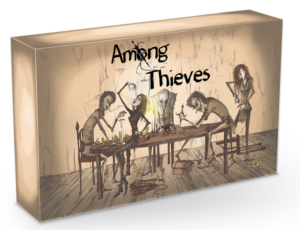
This actually happened to me twice during the two year development of No Honor Among Thieves. First, back in October of 2015, I was contacted by a very nice Bulgarian gentleman who said that he’d been working on a game called No Honor Among Thieves for a couple months, and maybe we should talk about the name. Since I’d been working on mine since 2014, he agreed to change the name of his to Among Thieves. We’ve talked a lot since then, comparing strategies and contacts and plans for our Kickstarters, so things worked out really well for both of us.
Among Thieves just launched on Kickstarter, and it looks great–I’m planning on backing.
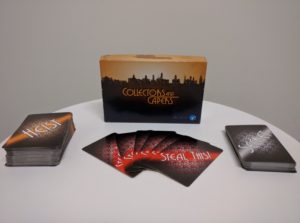
The second time was a bit more complicated. In May, I was sending emails to reviewers asking if they would like review copies of the game, and one critic told me that he’d gotten an email from “Trevor” within the hour of me contacting him, and maybe we should talk to each other more about splitting up the list of people to contact. He’d assumed that me and Trevor Harron of Blue Heron Games, who had also been working on a game called No Honor Among Thieves, were working on the same project. We weren’t. This one was trickier to sort out, because while I’d been working on my game for a fair bit longer, Blue Heron Games had filed for a trademark on No Honor Among Thieves just a couple months previously. Because I’d spent so much time and effort on the project with the name I offered to buy the trademark off of him and reimburse him for his branding expenses thus far, which he agreed to. Kind of an expensive lesson, but I really didn’t want to change the name of my game at that point, and I saw it as largely my fault for deciding I didn’t need to bother with registering a trademark when it was suggested to me the first time this happened. Blue Heron’s game is now called Collectors and Capers, and I get to keep mine as No Honor Among Thieves, and everyone walks away happy once again.
Collectors & Capers is currently seeking funding on Kickstarter. I’ve already backed it, and I’m looking forward to seeing what this other game with a similar name is like.
Here’s the lesson: don’t get too attached to the name of your game unless you’re willing to take the time and spend the money securing it. This isn’t something that had come up anywhere in all my research before I started working on this project, and hopefully me bringing it up here can prevent other people from having it happen to them, too. As for myself, I think I’m going to make up some words to use in the title of my next game.
There’s a lot more advice I’ve found, heard and tried to implement over the years that I’ve been accumulating it, but these are the ones that stick out as being most-often repeated. My plan is to write another one of these posts after I’ve run my Kickstarter and see if my opinions have changed over the course of it, or if I feel like anything needs to be added.
If you think I’ve missed anything, let me know in the comments.
Sources:
Stonemaier Games Kickstarter Lessons: Jamey Stegmaier has written 195 Kickstarter Lessons posts at the time of this writing. And that’s just the ones he’s put numbers on–there’s any number of interviews, guest posts, top ten lists, comparisons, and retrospectives on his blog that aren’t included in the main Kickstarter Lessons series, but are nonetheless immeasurably useful. Of all the sources I’ve consulted over the years, Jamey is the one most likely to repeat himself, usually by coming at the same topic from a different direction or expanding upon one subsection of an earlier post in a later one, but it’s all really good, really nuanced advice, and I urge you to read it yourself if my six-point summary in this post isn’t detailed enough for you. Stonemaier Games’ blog is the grit from which I refined my takeaway lessons.
James Mathe’s blog: James Mathe is the founder of five different companies, runs three gaming stores, and has been running tabletop game Kickstarters for as long as it was practical to do so. The most practically useful posts on his blog for any new game publisher or developer are the detailed breakdowns of his previous campaigns and his collections of links, such as his lists of reviewers, manufacturers and video producers. His advice on how to build a crowd without being skeevy about it is also fantastic. As a note, this blog is definitely quality over quantity, and he doesn’t post super often, but what he does post is always gold.
Genius Games Kickstarter Advice: Genius Games ran a series of blog posts in 2014 breaking down every step of the process they went through to crowdfund and publish their game Linkage. The series is unfortunately incomplete, ending with part one of what was presumably intended to be a two-part post, but the seven posts in the series all have a wonderfully statistics-driven way of looking at the platform that I think anyone can benefit from looking into. And speaking of statistics…
Genius Games Kickstarter Statistics: Here we have more statistical analysis from Genius Games, covering everything from how likely a project run by someone who’s backed a lot of other projects is to be successful to what days successful projects tend to launch on.
Kickstarter Best Practices Facebook Group: This is the biggest group of Kickstarter veterans you’ll find on Facebook, and one that’s willing to give brutally honest advice. Even if you don’t ask them questions yourself, it’s worth your while to join in and see what the conversation is about.
Tabletop Kickstarter Advice Facebook Group: This is a great place to ask questions, or to give advice if you’ve got a little more experience.
Tabletop Game Design Subreddit: Also a good place to ask for advice, or to give advice. There’s a bunch of passionate people here, and the pseudo-anonymity when compared to Facebook makes them more likely to give you the harsh advice that you might need to hear.
Board Game Geek’s Kickstarter Forum: BGG had 1.2 million members in 2015, and that number is only growing. This is the place to talk about games online, and if you’re planning on making games you probably ought to join the conversation.
I would also like to give a shoutout to every Kickstarter panel at PAX East for the last five years, as I’ve attended most of them. Thanks for sitting up there and letting people like me ask uninformed questions from the audience. Your patience with my inanity has been legendary in nature.


Paul Spencer ,
Great read. Really enjoyed this condensed version. I feel like I was starting to get bogged down in the little details. This is a really focused article on what really matters! Thanks
André Forsblom ,
Well written article! It includes many essential lessons in a good and concise way.